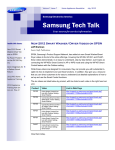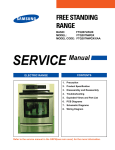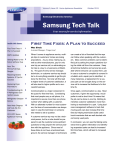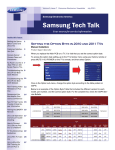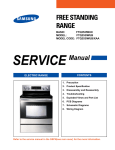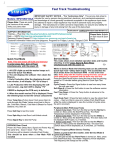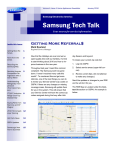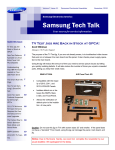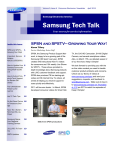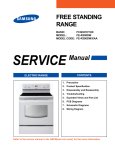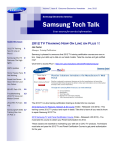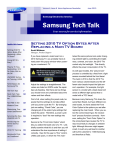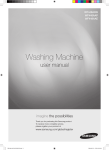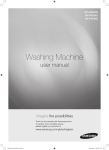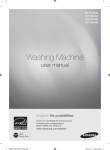Download Samsung DV431AEP/XAA Technical data
Transcript
Volume 5, Issue 7 Home Appliances Newsletter July 2011 Samsung Electronics America Samsung Tech Talk Your source for service information Improving Home Appliance Defect Description Details Inside this issue: Improving Home Appliance Defect Description Details 1 GSPN Updates 2 Elisa Pagliaro Staff A Customer Satisfac- 3 tion Quiz Troubleshooting cook Top Dual and Triple Surface Heating Element Problems 4 Efficient Dryer Troubleshooting 7 We would like to remind all Samsung ASCs that detailed symptom and repair descriptions are critical in helping Samsung engineers. This valuable information can help Samsung create helpful service bulletins and tips, produce more accurate service materials, and help improve our customers overall satisfaction. We ask that you specifically focus on adding details in No defect/No problem found cases (NDF). New Steps Added to 9 Dryer Pulley Replacement Bulletin HE Detergent and 10 Front Loading Washers Adjusting French Door Refrigerator Doors 9 2011 RTC Home Appliance Training 11 2011 Home Appliance Training Now On Line on Plus 1! 12 Please use the Defect Desc and Repair Desc fields when filing your warranty claims to add the repair details. See the illustration below for their location. Volume 5, Issue 7 Home Appliances Newsletter Samsung Tech Talk GSPN Updates Jeff Brutman Senior Staff, Publications We encourage you to use our GSPN site to find the latest service bulletins to aid you with your repairs. http://service.samsungportal.com HA Service Bulletins uploaded to GSPN June, 2011: Bulletin Number Subject Applicable Models ASC20110628001 Drum motor version parts change. WF511ABR/XAA WF511ABW/XAA WF431ABP/XAA WF431ABW/XAA ASC20110628002 Weight balancer part change. WF461ABP/XAA WF461ABW/XAA WF448AAE/XAA WF448AAG/XAA WF448AAP/XAA ASC20110628003 Thermistor wiring harness part change. WA5471ABP/XAA WA5471ABW/XAA To access service bulletins on GSPN, first visit http://service.samsungportal.com. Login using your User ID and Password. Click on “Documents” at the top, then “Product Information” in the left column. The Product Information menu will appear. Click on “Service Bulletin (Local) to bring up the Service Bulletins. To search for a bulletin, enter the bulletin number in the search window at the upper left. If for some reason the bulletin does not appear, it can still be searched using the “Select Depth 1, 2, and 3” drop-down menus. Page 2 Volume 5, Issue 7 Home Appliances Newsletter Samsung Tech Talk A Customer Satisfaction Quiz Wes Sirios Assistant Manager, Triage Lead Customer Satisfaction is one of the most important components of a successful service business. Since the main product being sold is service, how that product is delivered to your customers can mean the difference between a profitable organization and one that struggles to stay afloat. Asking yourself a few important questions about your operation (and answering them honestly) on a regular basis can help you keep your business in the black. Here are a few questions to get you started: Would I want my mother to call this business to schedule service? Customer satisfaction begins with the initial call from the customer. How the people that man your phones speak with your customers is critical. A pleasant voice and a good attitude should be what the customer hears over the phone. It does not matter how uncooperative or rude a customer may be, the person taking the call should remain calm, allow the customer to vent, and offer solutions to the problem at hand. Are my office procedures conducive to customer satisfaction? Take a look at the flow of your daily processes. Make sure that all service tickets are accounted for and that customers who are waiting for parts are kept informed about the availability of the parts. A major cause for dissatisfaction is a lack of communication between the office and the customer. Parts should be ordered on a daily basis to lessen the turnaround time of service calls. Are my technicians properly dressed and groomed? A professional service organization provides its technicians with uniforms. These garments should be clean and should fit the technician properly. First impressions can make all the difference and proper attire is the first thing a customer sees when the tech arrives at the home. Along these same lines, all techs should have proper shoes and shoe covers, soft tools bags or pouches, protective mats, and any item that demonstrates the tech’s concern for the customer’s property. Do my technicians keep up their product knowledge? Online training, classroom sessions, technical support, and service manuals are available to help technicians with their daily job performance. All techs should be aware of how to access this information and should take advantage of any opportunity to enhance their knowledge. These are just a few of the questions you should ask yourself on a regular basis. Positive answers to these questions will help ensure that your business is successful and your customers are happy with their service experiences. Page 3 Volume 5, Issue 7 Home Appliances Newsletter Samsung Tech Talk Troubleshooting Cook Top Dual and Triple Surface Heating Element Problems Paul Pieri Trainer—RTSC When the surface heating elements are not operating properly, try to determine if the surface element, regulator, or main PCB is the cause of the problem. You can do this in most cases without having to remove the cook top to get to the heaters. The technical data and illustrations below are taken from the FTQ387 and the FE710 Flex-Duo range, but apply to any range with dual and/or triple function surface heaters. Dual Surface Heater The dual regulator can control the center element only or the center and outer elements together. Triple Surface Heater The triple regulator can control the center only, center and middle only, or center, middle, and outer elements. Page 4 Volume 5, Issue 7 Home Appliances Newsletter Samsung Tech Talk Troubleshooting Cook Top Dual and Triple Surface Heating Element Problems continued Dual Surface Heating Element Regulator and Circuit The terminal connections on the wiring diagram refer to the regulator terminals. The center and outer elements can be measured independently of each other. Also check the internal TCO of the regulator. Center Element: Terminal 2 to 4 = 45 ~ 55Ω Outer Element: Terminal 2 to 4A = 40 ~ 50Ω Triple Surface Heating Element Regulator and Circuit The triple heating element and regulator are similar to the dual. Each element is measured independently. Center Element: 2 to 4 = 45 ~ 55Ω Middle Element: 2 to 4 Top = 65 ~ 75Ω (switch must be set to the full position Outer Element: 2 to 4a = 45 ~ 55Ω Page 5 ) Volume 5, Issue 7 Home Appliances Newsletter Samsung Tech Talk Troubleshooting Cook Top Dual and Triple Surface Heating Element Problems continued You can measure all heating elements for resistance from the regulators first without disassembling the cook top. If these measurements show any discrepancies, then you'll need to dissemble the cook top to test the suspected surface element. Using the wiring diagram, you can also check the regulator switches for continuity. Please Send Us Your Comments! Something you’d like to see in the Samsung Tech Talk Newsletter? If there a topic/issue we haven’t covered that you’d like us to write about, LET US KNOW! Please send your comments to: [email protected] Page 6 Volume 5, Issue 7 Home Appliances Newsletter Samsung Tech Talk Efficient Dryer Troubleshooting Jim Swift, HA Product Senior Manager Steve Polzin, Technical Instructor, Appliance Tech Support Specialist When you encounter a no heat condition on an electric dryer, the fastest troubleshooting method uses the process of elimination. Step 1 - Confirm the AC supply voltage is correct. Check across L1 and L2 on the terminal block. If 220 VAC is not present, the problem is with the house power supply and the customer will need an electrician to resolve the issue. Step 2 - Verify the motor is working properly. Start the unit and listen for motor sounds and drum rotation. Step 3 – Verify the voltage is being supplied to the heater circuitry. Start accessing the main PCB located under the top panel and to the left of the drum. With the dryer running in a heat setting, take a voltage measurement across the heater relay between Bu and Blk. If your measurement is 0 VAC, then the heater relay is closing and the problem is elsewhere in the heater circuit. If 220 VAC is present across the relay, the relay is open and the problem is with either the main PCB or the thermistor. Dryer Supply Voltage To determine which one is defective, simply identify the low voltage connector with the blue and red thermistor leads, unplug it, and then take a resistance measurement. At room temperature, the thermistor should measure approximately 10K. Using the chart provided to the right, and also found in the fast track manual, evaluate the thermistor reading. Low resistance would send a signal to the micro processor falsely indicating that high temperature was present, preventing the dryer from heating. If the thermistor is within an acceptable range based upon your conversion, replace the main PCB to complete the repair. If your measurement across the heater relay is 0 VAC, then the problem is elsewhere in the heater circuit. Sensor Circuitry Step 4: Testing the safety circuits - Further disassembly will be required to carry out your diagnostics testing. Unplug the unit from the power source, and then remove the console, front panel, and front bulkhead assembly. Next, remove the belt and drum assembly as needed to access the burner assembly. Once you have located the burner assembly, check the TH2 Hi Limit and the TH3 Safety thermostats. Both should be closed and the heating element should measure approximately 10 ohms. Page 7 Volume 5, Issue 7 Home Appliances Newsletter Samsung Tech Talk Efficient Dryer Troubleshooting continued The TH2 High Limit thermostat opens when temperatures inside the heater box reach 260°F and turns the heater off. It automatically resets when the temperature drops below 170°F, turning the heater back on. This is normal operation as it prevents overheating when air movement is reduced from large loads, a dirty lint filter, or a long vent. The TH3 thermostat is a safety thermostat or thermal fuse that will open if the heater box reaches 320°F and will not reset. If you find TH3 open, always replace the TH2 cycling thermostat as well as it has probably been damaged from overheating. Additionally, make a thorough inspection of the external vent looking for any type of airflow restriction. A venting issue probably caused the heater to burn hotter because of reduced air flow. Poor venting also causes long, inefficient drying times and can lead to premature failure of all three of the heater assembly components. Step 5 - If the problem has not yet been identified, the last remaining item in the circuit is the centrifugal switch located on the motor. Use extreme caution as the motor needs to be running to check the switch properly. You will need to bypass the door switch and the belt switch before restoring power to the unit. With a heat setting selected, start the unit and measure across the centrifugal switch by placing your meter leads on the two red wires. If the switch is open, you will read 220 VAC indicating a bad motor. The information in this article applies to every electric dryer Samsung makes. Next month: A quick, accurate diagnostic procedure for Samsung gas dryer models. Page 8 Safety Circuitry Centrifugal Switch Circuit Volume 5, Issue 7 Home Appliances Newsletter Samsung Tech Talk New Steps added to Dryer Pulley Replacement Bulletin Nicholas Webert Regional Technical Trainer Samsung has added new steps to Bulletin ASC20100624001 (Bulletin Date: September 20, 2010) which explains how to install a new motor pulley if a dryer belt has fallen off the factory installed motor pulley. In addition to installing a new motor pulley, you now also need to align the idler pulley and motor pulley. Below are two pictures. The picture on the left shows an incorrect alignment of the idler and motor pulleys. The picture on the right shows a correct alignment. The arrows indicate how the pulleys should be aligned. Please review Bulletin ASC20100624 and perform the additional steps with all pulley replacements. Pulley out of Position The idler pulley Is not in alignment with the motor pulley. This example is exaggerated, but be aware that in all cases, you will need to align the two pulleys when you replace the motor pulley. Pulley in Position The idler pulley is in direct alignment with the motor pulley. Note: To prevent the dryer belt from sliding off the pulley, the pulley has been re-designed. The O.D has been changed from 22mm to 27mm. Old Motor Pulley O.D. Page 9 New Motor Pulley O.D. Volume 5, Issue 7 Home Appliances Newsletter Samsung Tech Talk HE Detergent and Front Loading Washers Louis Picchione Assistant Manager—HA Since the introduction of the front-loading washing machine into the North American market, their sales have literally exploded, driven primarily by the money they can save. The claims about their efficiency are true. When operated properly, a front loading washing machine can save energy, water, and money. Plus they do a good job of washing your clothes. But, if you are using the wrong detergent or too much of the right detergent, your expectation of savings can quickly disappear. All front-loading washing machine need a special detergent. It's called HE (High Efficiency) detergent. If you do not use HE detergent in your washer, the unit will not clean properly. Using regular detergent may even cause mechanical problems in your front loader. HE detergent is a type of non-sudsing detergent. In fact, while operating, the machine almost appears not to have any detergent inside. Unfortunately, consumers have become so used to seeing suds in their old washing machines that they mistakenly relate the presence of suds to proper operation. Nothing could be farther from the truth. An old fashioned top loader washes your clothes by constantly tumbling them through a full tub of water. The new energy efficient front loaders work differently. In the front loading washer, your clothes are picked up by lifters inside the drum, lifted to the top of the drum, and then dropped into water lying at the bottom of the drum. The process of being dropped and hitting the water dislodges the dirt from the clothing fibers. Later, the drum stops turning, the water flows out the bottom of the drum via the drain pump and takes both water and dirt out to the household drain. Finally, the drum spins at very high speed to remove the final amounts of water, dirt, and detergent from the clothes. This frontloading process of cleaning your clothes is both simple Page 10 and dependable. But, this simple method stops working if there is too much suds being produced by your laundry detergent. If you are using regular detergent in your front loader, excess suds will be produced by the interaction of the detergent and tumbling water. The unwanted suds will accumulate at the bottom of the washer drum where it will lie on top of the water. These suds will act as a big fluffy cushion. This cushion hinders clothes from reaching the water. As your clothes fall from the top of the drum to the bottom, they will hit the suds cushion rather than the water. The result is a very poor wash. Even owners of front loaders who are using the correct detergent can misunderstand how to use it properly. Not seeing any suds, they think they require more detergent. They keep increasing the amount used per load until suds finally appear. This can be a costly mistake that again results in a poor wash. Using too much detergent is as bad as using the wrong detergent. Extreme amounts of detergent can produce symptoms such as leaking, vibration, noisy operation, and poor spinning. If you have been using the wrong detergent (or the proper type incorrectly) in your front loading washer, try the following suggestions. Run the machine through a number of cycles using hot water. This should help expel the old detergent. It usually takes 3 or 4 cycles to wash away the old detergent accumulated inside the machine. You can also add a product that removes the build-up of old detergent. It is a good idea to use a cleaner in your front loader every few months. It is an inexpensive form of regular maintenance. It is also important to clean the detergent dispenser drawer to remove any residue from the compartments. If your washer is not working as well as anticipated, look to your laundry detergent. If it does not say HE on the label -- switch immediately. Volume 5, Issue 7 Home Appliances Newsletter Samsung Tech Talk 2011 RTC Home Appliance Training Samsung HA Training 2011 Being held at one of our four Regional Training Centers! Attend in depth, hands-on training at one of our RTCs. You can reserve your seat for training by emailing [email protected]. Additionally, Home Appliance training is available on-demand 24/7 at https://my.plus1solutions.net/clientPortals/samsung/ Training schedule: Date July 26-28, 2011 City Rancho Dominquez, CA Bensenville, IL July 26-28, 2011 Austell, GA ME/ASC Training August 2-4, 2011 Little Ferry, NJ ME/ASC Training August 2-4, 2011 Rancho Dominquez, CA ME/ASC Training August 23-25, 2011 Bensenville, IL ME/ASC Training August 23-25, 2011 Austell, GA ME/ASC Training July 5-7, 2011 Page 11 Comments ME/ASC Training ME/ASC Training Volume 5, Issue 7 Home Appliances Newsletter Samsung Tech Talk 2011 Home Appliance Training Now On-Line on Plus 1! Jim Foster Manager, Training /Publications Samsung is pleased to announce that the 2011 Home Appliance On-line Training courses are now on Plus 1: 2011 Samsung Sealed System Repair Training 2011 Samsung Wi-Fi Refrigerator Training 2011 Samsung Refrigerator Troubleshooting Training 2011 Samsung Top Load Washer Training 2011 Samsung Laundry Troubleshooting Guide Training Keep your skills up to date. All techs must complete and pass training annually to maintain certification. Plus 1 can be accessed at: https://my.plus1solutions.net/clientPortals/samsung/ GET CERTIFIED NOW! Samsung Electronics America 85 Challenger Road Ridgefield Park, NJ 07660 This information in this bulletin is published for informational purposes only and intended for use Phone: 201-229-4251 ered by electricity. Any attempt to handle, service or repair the product or products by anyone other only by personnel qualified for the specific tasks depicted. Qualified personnel are those who, based on their training and experience, are capable of identifying risks and avoiding potential hazards when handling or servicing a product. Only qualified personnel should repair products powthan qualified personnel could result in serious injury or death. You agree that your use of and reliance on this information is at your sole risk. This information is subject to change or update without notice. There are no warranties, either expressed or implied, regarding the accuracy or completeness of this information Page 12













